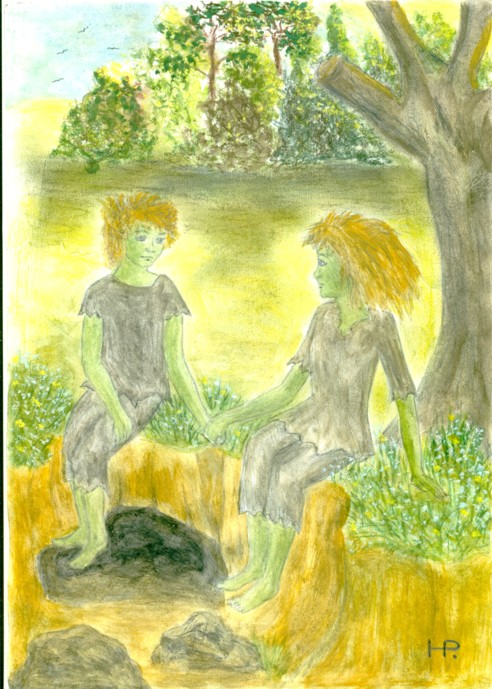12th Century Legend of the Green Children of Woolpit , Suffolk, UK
The legend of the green children of Woolpit
concerns two children of unusual skin colour who reportedly appeared in
the village of Wool Pit in Suffolk, England, some time in the 12th
century, perhaps during the reign of King Stephen. The children,
brother and sister, were of generally normal appearance except for the
green colour of their skin. They spoke in an unknown language, and the
only food they would eat was beans. Eventually they learned to eat
other
food and lost their green pallor, but the boy was sickly and died
soon after he and his sister were baptised. The girl adjusted to her
new life, but she was considered to be "rather loose and wanton in her
conduct". After she learned to speak English, the girl explained that
she and her brother had come from St Martin's Land, an underground
world whose inhabitants are green.
One day at harvest time, according to William of Newburgh during the
reign of King Stephen (1135–1154), the
villagers of Woolpit discovered two children, a brother and sister,
beside one
of the wolf pits that gave the village its name. Their
skin was green, they spoke an unknown language, and their clothing was
unfamiliar. Ralph reports that the children were taken to the home of
Richard de Calne. Ralph and William agree that the pair refused all
food for several days until they came across some raw beans, which they
consumed eagerly. The
children gradually adapted to normal food and in time lost their green
colour. The boy, who appeared to be the younger of the two, became
sickly and died shortly after he and his sister were baptised.
After
learning to speak English, the children – Ralph says just the
surviving girl – explained that they came from a land where the
sun never shone and the light was like twilight. William says
the
children called their home St Martin's Land; Ralph adds that everything
there was green. According to William, the children were unable to
account for their arrival in Woolpit; they had been herding their
father's cattle when they heard a loud noise (according to William, the
bells
of Bury St Edmunds and
suddenly found themselves by the wolf pit where they were found. Ralph
says that they had become lost when they followed the cattle into a
cave and, after
being guided by the sound of bells, eventually emerged
into our land.
According to Ralph, the girl was employed for many
years as a servant in Richard de Calne's household, where she was
considered to be "very wanton and impudent". William says that she
eventually married a man from King's Lynn, about 40 miles (64 km)
from Woolpit, where she
was still living shortly before he wrote. Based
on his research into Richard de Calne's family
history, the astronomer
and writer Duncan Lunan has concluded that the girl was given the
name "Agnes" and that she married a royal official named Richard
Barre.
The only near-contemporary accounts are contained in William of Newburgh's Historia rerum Anglicarum and Ralph of Coggeshall's Chronicum Anglicanum, written in about 1189 and 1220 respectively. Between then and their rediscovery in the mid-19th century, the green children seem to surface only in a passing mention in William Camden's Britannia in 1586, and in Bishop Francis Godwin's fantastical The Man in the Moone, in both of which William of Newburgh's account is cited.
Two
approaches have dominated explanations of the story of the green
children: that it is a
folk tale describing an imaginary encounter with
the inhabitants of another world, perhaps one beneath our feet or even
extraterrestrial, or it is a garbled account of a historical event.
The
story was praised as an ideal fantasy by the English anarchist poet and
critic Herbert Read
in his English Prose Style, published in 1931. It
provided the inspiration for his only novel, The Green Child written in
1934.
Our Lady of Woolpit:
Until the Reformation the church housed a richly adorned statue of the Virgin Mary known as
"Our Lady of Woolpit", which was an object of veneration and
pilgrimage, perhaps as early as about 1211. There is a clear indication
of the existence of an image of the Virgin in a mid-15th century will
that speaks of "tabernaculum beate Mariae de novo faciendo" ("in making
new/anew the tabernacle of Blessed Mary"), which sounds at least like a
canopy or even a chapel for housing an image. It stood in its own
chapel within the church. No trace of the chapel survives, but it may
have been situated at the east end of the south aisle, or more probably
on the north side of the chancel in the area now occupied by the
19th-century vestry.
Pilgrimage to Our Lady of Woolpit seems to have been particularly
popular in the 15th and early 16th centuries, and the shrine was
visited twice by King Henry VI, in 1448 and 1449.
In 1481 John, Lord Howard (from 1483 created Duke of Norfolk by Richard
III), left a massive £7 9s as an offering for the shrine. After the
Tudor dynasty had consolidated its hold on the English throne, Henry
VII's queen, Elizabeth of York, made a donation in 1502 of 20d to the
shrine.
The statue was removed or destroyed after 1538, when Henry VIII ordered
the taking down of "feigned images abused with Pilgrimages and
Offerings" throughout England; the chapel was demolished in 1551, on a
warrant from the Court of Augmentations.
The Lady's Well of Woolpit:
In a field about 300 yards north-east of the church there is a small
irregular moated enclosure of unknown date, largely covered by trees
and bushes and now a nature reserve. The moat is partially filled by
water rising from a natural spring, protected by modern brickwork, on
the south side; the moated site and the spring constitute a scheduled
ancient monument.
The spring is known as the Lady's Well or Lady Well. Although there are
earlier references to a well or spring, it is first named as "Our Ladys
Well" in a document dated between 1573 and 1576, referring to a
manorial court meeting in 1557–58.[9] The name suggests that it was
once a holy well dedicated like the church and statue to the Virgin
Mary, and it has been suggested that the well itself was a place of
medieval pilgrimage.[16] There is no evidence to suggest that there was
ever a building at the site of the well, or even to support the
claim of its being a specific goal of pilgrimage. In fact the well was
on land held not by the parish church but by the chapel of St John at
Palgrave.
At some unknown point, a local tradition arose that the waters of the
spring had healing properties. A writer in 1827 described the Lady's
Well as a perpetual spring about two feet deep of beautifully clear
water, and so cold that a hand immersed in it is very soon benumbed. It
is used occasionally for the immersion of weakly children, and much
resorted to by persons of weak eyes. Analysis of the water in the 1970s
showed that it has a high sulphate content, which may have been of some
benefit in the treatment of eye infections.
Source: Wikipedia
Illustration by Hilary Porter


